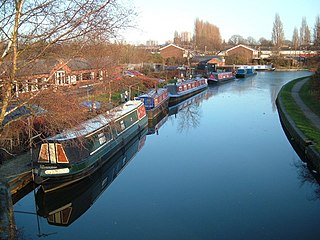
The Wyrley and Essington Canal, known locally as "the Curly Wyrley", is a canal in the English Midlands. As built it ran from Wolverhampton to Huddlesford Junction near Lichfield, with a number of branches: some parts are currently derelict. Pending planned restoration to Huddlesford, the navigable mainline now terminates at Ogley Junction near Brownhills. In 2008 it was designated a Local Nature Reserve.

The Barnsley Canal is a canal that ran from Barnby Basin, through Barnsley, South Yorkshire, England to a junction with the Aire and Calder Navigation near Wakefield, West Yorkshire. It was built in the 1790s, to provide a transport link from coal reserves at Barnsley to a wider market. Both the Aire and Calder Navigation and the River Don Navigation took a keen interest in the project, the former buying many of the initial shares, and the latter constructing the Dearne and Dove Canal to link the canal to their waterway. Water supply issues meant that the Aire and Calder proposed pumping all of the water for the canal from the River Calder, using steam pumps, but a reservoir was built at Cold Hiendley instead, increasing the construction costs, but reducing the running costs. The canal as built was 14.5 miles (23.3 km) long and included 15 locks.

The Dearne and Dove Canal ran for almost ten miles through South Yorkshire, England from Swinton to Barnsley through nineteen locks, rising 127 feet (39 m). The canal also had two short branches, the Worsbrough branch and the Elsecar branch, both about two miles long with reservoirs at the head of each. The Elsecar branch also has another six locks. The only tunnel was bypassed by a cutting in 1840.
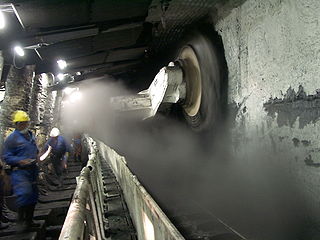
Longwall mining is a form of underground coal mining where a long wall of coal is mined in a single slice. The longwall panel is typically 3–4 km (1.9–2.5 mi) long and 250–400 m (820–1,310 ft) wide.
Pennsylvania Coal Co. v. Mahon, 260 U.S. 393 (1922), was a case in which the Supreme Court of the United States held that whether a regulatory act constitutes a taking requiring compensation depends on the extent of diminution in the value of the property.
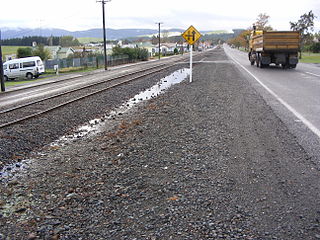
Ohai is a town in the Southland region of New Zealand's South Island, 65 kilometres northwest of Invercargill and 25 kilometres west of Winton. The 2013 New Zealand census gave its population as 303, a decline of 54 people since the 2006 census. https://www.southlandexpress.co.nz/property-news/affordable-housing-a-boon-for-ohai/

The Nutbrook Canal was a canal in England which ran between Shipley in Derbyshire and the Erewash Canal, joining it near Trowell. It was built to serve the collieries at Shipley and West Hallam, and was completed in 1796. It was initially profitable, but from 1846 faced competition from the railways, and more seriously, subsidence caused by the coal mines that it was built to serve. With the mines failing to pay tolls for goods carried on the canal, and in some cases refusing to accept responsibility for the subsidence, most of it was closed in 1895, although the final 1.5 miles (2.4 km) remained in use until 1949.
Keystone Bituminous Coal Ass'n v. DeBenedictis, 480 U.S. 470 (1987), is an important United States Supreme Court case interpreting the Fifth Amendment's Takings Clause. In this case, the court upheld a Pennsylvania statute which limited coal mining causing damage to buildings, dwellings, and cemeteries through subsidence.
The New South Wales Coal Compensation Board was a government body in New South Wales which had responsibility for determining compensation payable when coal in the state was compulsorily acquired in 1981.
The New South Wales Coal Compensation Review Tribunal was a tribunal in New South Wales, a state of Australia, which had responsibility for determining appeals about compensation payable when coal in the state was compulsorily acquired during 1981. The tribunal was in operation between 1985 and 1 January 2008.
Room and pillar, is a mining system in which the mined material is extracted across a horizontal plane, creating horizontal arrays of rooms and pillars. To do this, "rooms" of ore are dug out while "pillars" of untouched material are left to support the roof overburden. Calculating the size, shape, and position of pillars is a complicated procedure, and is an area of active research. The technique is usually used for relatively flat-lying deposits, such as those that follow a particular stratum. Room and pillar mining can be advantageous because it reduces the risk of surface subsidence compared to other underground mining techniques. It is also advantageous because it can be mechanized, and is relatively simple. However, because significant portions of ore may have to be left behind, recovery and profits can be low. Room and pillar mining was one of the earliest methods used, although with significantly more man-power.

The Coal Authority is a non-departmental public body of the United Kingdom government sponsored by the Department for Business, Energy & Industrial Strategy. It owns the vast majority of unworked coal in Great Britain, as well as former coal mines, and undertakes a range of functions including:
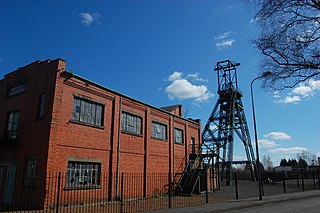
Bersham Colliery was a large coal mine located near Rhostyllen in Wrexham County Borough, Wales. The mine accessed seams found in the Denbighshire Coalfield.
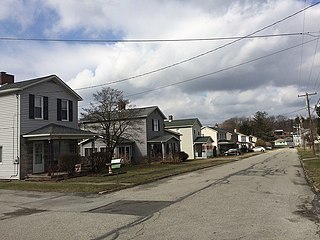
Bradenville is a Census-designated place and coal town in Derry Township in Westmoreland County, Pennsylvania, United States. The community is located within 2 miles of the city of Latrobe and 3 miles from the borough of Derry, Pennsylvania. It has a total area of 0.4 miles. Bradenville has its own post office with zip code 15620.

The Land Drainage Act 1930 was an Act of Parliament passed by the United Kingdom Government which provided a new set of administrative structures to ensure that drainage of low-lying land could be managed effectively. It followed the proposals of a royal commission which sat during 1927.

Gillieston Heights is a suburb of the City of Maitland local government area in the Hunter Region of New South Wales, Australia, approximately 5.1 km (3.2 mi) from the Maitland CBD. Prior to 1967, the village was named East Greta however this was changed to honour former Maitland mayor and member of the New South Wales Legislative Assembly John Gillies following a poll of residents. At the 2016 census, Gillieston Heights had a population of over 3,000.
The Coalbrook mining disaster is the worst mining disaster in the history of South Africa. The disaster occurred in the Coalbrook coal mine of Clydesdale Colliery on 21 January 1960 at around 19:00 when approximately 900 pillars caved in, almost 180 metres underground. The mine is situated in the Northern Free State, 21 km south west of Vereeniging. About 1,000 miners were in the mine at the time and 437 died after being trapped, while the rest escaped through an incline shaft. The miners were suffocated by methane gas and crushed to death by rockfall.

The Emschergenossenschaft is the oldest and biggest public German water board, („Wasserwirtschaftsverband”) located in Essen and responsible for the 865 km² Emscher catchment with 2.2 Mio. citizens. The main tasks are wastewater discharge and treatment, flood protection, groundwater management, settlement of claims caused by hard coal mining, river restoration and protection of ecosystems.

Newcastle Government House is a heritage-listed former military post and official residence and now park and psychiatric hospital at 72 Watt Street, Newcastle, New South Wales, Australia. It is also known as Newcastle Government House and Domain, Newcastle Military Barracks & Hospital, Girls' Industrial School, Reformatory for Girls, Lunatic Asylum for Imbeciles, James Fletcher Hospital and Fletcher Park. It was added to the New South Wales State Heritage Register on 22 March 2011.












